Analysis of Spatiotemporal Variation Characteristics and Driving Factors of Drought in Yinshanbeilu Inner Mongolia Based on a Cloud Model
Abstract
1. Introduction
2. Data and Methodology
2.1. Study Region
2.2. Data Source
2.3. Research Methodology
2.3.1. SPI and Drought Levels
2.3.2. Drought Frequency
2.3.3. Cloud Generator Algorithm
- (1)
- Ex is equivalent to the expected value rank-squared estimate in statistical theory, reflecting the expected value of the spatial distribution of the thesis domain, i.e., the spatial distribution of the centre of gravity of the cloud droplets.
- (2)
- En corresponds to the variance of the likelihood distribution in statistical theory, reflecting the range of cloud drops accepted by the qualitative concepts in the domain space.
- (3)
- He corresponds to the hyperparameters in statistical theory and is a measure of uncertainty in entropy.
2.3.4. Cross-Wavelet Transform Technology
3. Results and Analyses
3.1. Characteristics of Spatial and Temporal Distribution of Drought
3.1.1. Annual Scale SPI-12 Distributional Characteristics
3.1.2. Seasonal Scale SPI-3 Distributional Characteristics
3.2. Drought Analysis Based on the Cloud Model
3.2.1. Cloud Characterisation of SPI-12
3.2.2. Cloud Characterisation of SPI-3
3.3. Drivers of Drought
4. Discussion
4.1. Spatial and Temporal Variability of Drought
4.2. Drought Drivers
4.3. Uncertainties and Limitations
5. Conclusions
- (1)
- Drought in the Yinshanbeilu region shows a spatial trend of high frequency of drought in the east and west and a low frequency of drought in the north and south. Drought in all seasons shows a fluctuating downward trend, with winter drought trending the most clearly and autumn drought trending the least, with the greatest inter-regional and inter-annual differences.
- (2)
- Cloud model analyses using annual-scale SPI-12 as a sample show that the Ex linear propensity ratio shows an increasing trend of 1.28/10a, so that the overall trend of drought at stations in the Yinshanbeilu region has tended to weaken over the past 50 years. SPI stochasticity was significantly reduced and tended to be stable and homogeneous across sites, with greater certainty and stability of SPI across sites in drought years. Spatially, inter-annual SPI stochasticity was weaker but more stable at sites with higher aridity. In addition, the inter-annual variation in SPI cloud model eigenvalues was greater than the variation between sites, with greater stochasticity and inhomogeneity in SPI between years. Cloud model analysis using seasonal-scale SPI-3 as a sample shows that Ex is smaller throughout the year, En is also smaller, and He is larger.
- (3)
- The six large-scale circulation factors, PET and PRE, drive the occurrence of drought. ENSO, AO, NAO, sunspot, PET, and PRE are all positively correlated with drought, among which sunspot, PET, and PRE have the strongest correlation with drought in the Yinshanbeilu region, while PDO and AMO are negatively correlated with drought.
Author Contributions
Funding
Data Availability Statement
Acknowledgments
Conflicts of Interest
References
- Zhang, Q.; Han, L.; Jia, J.; Song, L.; Wang, J. Management of drought risk under global warming. Theor. Appl. Climatol. 2016, 125, 187–196. [Google Scholar] [CrossRef]
- Su, B.; Huang, J.; Fischer, T.; Wang, Y.; Kundzewicz, Z.W.; Zhai, J.; Sun, H.; Wang, A.; Zeng, X.; Wang, G. Drought losses in China might double between the 1.5 C and 2.0 C warming. Proc. Natl. Acad. Sci. USA 2018, 115, 10600–10605. [Google Scholar] [CrossRef]
- Sun, Y.; Miao, F.; Wang, Y.; Liu, H.; Wang, X.; Wang, H.; Guo, J.; Shao, R.; Yang, Q. L-Arginine alleviates the reduction in photosynthesis and antioxidant activity induced by drought stress in maize seedlings. Antioxidants 2023, 12, 482. [Google Scholar] [CrossRef] [PubMed]
- Lei, Y.; Yue, Y.; Yin, Y.; Sheng, Z. How adjustments in land use patterns contribute to drought risk adaptation in a changing climate—A case study in China. Land Use Policy 2014, 36, 577–584. [Google Scholar] [CrossRef]
- Haile, G.G.; Tang, Q.; Li, W.; Liu, X.; Zhang, X. Drought: Progress in broadening its understanding. Wiley Interdiscip. Rev. Water 2020, 7, e1407. [Google Scholar] [CrossRef]
- Wan, L.; Bento, V.A.; Qu, Y.; Qiu, J.; Song, H.; Zhang, R.; Wu, X.; Xu, F.; Lu, J.; Wang, Q. Drought characteristics and dominant factors across China: Insights from high-resolution daily SPEI dataset between 1979 and 2018. Sci. Total Environ. 2023, 901, 166362. [Google Scholar] [CrossRef] [PubMed]
- Spinoni, J.; Barbosa, P.; De Jager, A.; McCormick, N.; Naumann, G.; Vogt, J.V.; Magni, D.; Masante, D.; Mazzeschi, M. A new global database of meteorological drought events from 1951 to 2016. J. Hydrol. Reg. Stud. 2019, 22, 100593. [Google Scholar] [CrossRef]
- Yue, S.; Yang, F.; Sheng, X. Spatiotemporal evolution and the driving factors of meteorological drought in the Hun-Taizi River basin, NE China. J. Water Clim. Chang. 2022, 13, 1326–1339. [Google Scholar] [CrossRef]
- Ault, T.R. On the essentials of drought in a changing climate. Science 2020, 368, 256–260. [Google Scholar] [CrossRef]
- McKee, T.B.; Doesken, N.J.; Kleist, J. The relationship of drought frequency and duration to time scales. In Proceedings of the 8th Conference on Applied Climatology, Anaheim, CA, USA, 17–22 January 1993; pp. 179–183. [Google Scholar]
- Dai, A.; Trenberth, K.E.; Qian, T. A global dataset of Palmer Drought Severity Index for 1870–2002: Relationship with soil moisture and effects of surface warming. J. Hydrometeorol. 2004, 5, 1117–1130. [Google Scholar] [CrossRef]
- Van Rooy, M. A rainfall anomally index independent of time and space. Notos 1965, 14, 43–48. [Google Scholar]
- Vicente-Serrano, S.M.; Beguería, S.; López-Moreno, J.I. A multiscalar drought index sensitive to global warming: The standardized precipitation evapotranspiration index. J. Clim. 2010, 23, 1696–1718. [Google Scholar] [CrossRef]
- Yang, P.; Zhai, X.; Huang, H.; Zhang, Y.; Zhu, Y.; Shi, X.; Zhou, L.; Fu, C. Association and driving factors of meteorological drought and agricultural drought in Ningxia, Northwest China. Atmos. Res. 2023, 289, 106753. [Google Scholar] [CrossRef]
- Mishra, A.K.; Singh, V.P. A review of drought concepts. J. Hydrol. 2010, 391, 202–216. [Google Scholar] [CrossRef]
- Christian, J.I.; Basara, J.B.; Otkin, J.A.; Hunt, E.D.; Wakefield, R.A.; Flanagan, P.X.; Xiao, X. A methodology for flash drought identification: Application of flash drought frequency across the United States. J. Hydrometeorol. 2019, 20, 833–846. [Google Scholar] [CrossRef]
- Gocic, M.; Trajkovic, S. Water surplus variability index as an indicator of drought. J. Hydrol. Eng. 2015, 20, 04014038. [Google Scholar] [CrossRef]
- Naresh Kumar, M.; Murthy, C.; Sesha Sai, M.; Roy, P. On the use of Standardized Precipitation Index (SPI) for drought intensity assessment. Meteorol. Appl. J. Forecast. Pract. Appl. Train. Tech. Model. 2009, 16, 381–389. [Google Scholar] [CrossRef]
- Bhunia, P.; Das, P.; Maiti, R. Meteorological drought study through SPI in three drought prone districts of West Bengal, India. Earth Syst. Environ. 2020, 4, 43–55. [Google Scholar] [CrossRef]
- Bahmani, S.; Naganna, S.R.; Ghorbani, M.A.; Shahabi, M.; Asadi, E.; Shahid, S. Geographically weighted regression hybridized with Kriging model for delineation of drought-prone Areas. Environ. Model. Assess. 2021, 26, 803–821. [Google Scholar] [CrossRef]
- Kim, T.-W.; Jehanzaib, M. Drought risk analysis, forecasting and assessment under climate change. Water 2020, 12, 1862. [Google Scholar] [CrossRef]
- Fu, Y.; Zhang, X.; Anderson, R.G.; Shi, R.; Wu, D.; Ge, Q. Spatiotemporal distribution of drought based on the standardized precipitation index and cloud models in the Haihe Plain, China. Water 2022, 14, 1672. [Google Scholar] [CrossRef]
- Li, D.; Liu, C.; Gan, W. A new cognitive model: Cloud model. Int. J. Intell. Syst. 2009, 24, 357–375. [Google Scholar] [CrossRef]
- Bai, X.; Wang, Y.; Jin, J.; Ning, S.; Wang, Y.; Wu, C. Spatio-temporal evolution analysis of drought based on cloud transformation algorithm over Northern Anhui Province. Entropy 2020, 22, 106. [Google Scholar] [CrossRef] [PubMed]
- Guo, Y.; Lu, X.; Zhang, J.; Li, K.; Wang, R.; Rong, G.; Liu, X.; Tong, Z. Joint analysis of drought and heat events during maize (Zea mays L.) growth periods using copula and cloud models: A case study of Songliao Plain. Agric. Water Manag. 2022, 259, 107238. [Google Scholar] [CrossRef]
- Pei, Z.; Fang, S.; Wang, L.; Yang, W. Comparative analysis of drought indicated by the SPI and SPEI at various timescales in inner Mongolia, China. Water 2020, 12, 1925. [Google Scholar] [CrossRef]
- Liu, S.; Kang, W.; Wang, T. Drought variability in Inner Mongolia of northern China during 1960–2013 based on standardized precipitation evapotranspiration index. Environ. Earth Sci. 2016, 75, 145. [Google Scholar] [CrossRef]
- Kikon, A.; Dodamani, B.; Barma, S.D.; Naganna, S.R. ANFIS-based soft computing models for forecasting effective drought index over an arid region of India. AQUA-Water Infrastruct. Ecosyst. Soc. 2023, 72, 930–946. [Google Scholar] [CrossRef]
- Hukkeri, G.S.; Naganna, S.R.; Pruthviraja, D.; Bhat, N.; Goudar, R. Drought forecasting: Application of ensemble and advanced machine learning approaches. IEEE Access 2023, 11, 141375–141393. [Google Scholar] [CrossRef]
- Wuyun, D.; Sun, L.; Chen, Z.; Hou, A.; Crusiol, L.G.T.; Yu, L.; Chen, R.; Sun, Z. The spatiotemporal change of cropland and its impact on vegetation dynamics in the farming-pastoral ecotone of northern China. Sci. Total Environ. 2022, 805, 150286. [Google Scholar] [CrossRef]
- Luo, D.; Ye, L.; Sun, D. Risk evaluation of agricultural drought disaster using a grey cloud clustering model in Henan province, China. Int. J. Disaster Risk Reduct. 2020, 49, 101759. [Google Scholar] [CrossRef]
- Wang, S.; Wang, W.; Wu, Y.; Li, W.; Zhao, S.; Chen, Z. Effects of a changing climate and anthropogenic impacts on net primary production in Yinshanbeilu, Inner Mongolia, China. Environ. Impact Assess. Rev. 2023, 102, 107185. [Google Scholar] [CrossRef]
- Zhang, H.; Gao, Y.; Meng, Z.; Chen, B.; Huang, L. Soil Organic Carbon Mineralization After the Addition of Plant Litter in Yinshanbeilu Desert Steppe under Three Utilization Regimes. Pol. J. Environ. Stud. 2022, 31, 4469–4479. [Google Scholar] [CrossRef]
- Svoboda, M.; Hayes, M.; Wood, D. Standardized Precipitation Index: User Guide; World Meteorological Organization: Geneva, Switzerland, 2012. [Google Scholar]
- Zhang, C.; Liu, H.; Song, Y.; Liao, Y.; Duan, J.; Cai, W.; Wang, S. Grades of Meteorological Drought; China Quality Inspection Press: Beijing, China, 2017. [Google Scholar]
- Wu, C.; Ning, S.; Jin, J.; Zhou, Y.; Zhou, L.; Bai, X.; Zhang, L.; Cui, Y. Construction and application of comprehensive drought index based on uncertainty cloud reasoning algorithm. Sci. Total Environ. 2021, 779, 146533. [Google Scholar] [CrossRef] [PubMed]
- Zhang, H.; Sun, Y.; Zhang, W.; Song, Z.; Ding, Z.; Zhang, X. Comprehensive evaluation of the eco-environmental vulnerability in the Yellow River Delta wetland. Ecol. Indic. 2021, 125, 107514. [Google Scholar] [CrossRef]
- Han, Z.; Huang, S.; Huang, Q.; Leng, G.; Wang, H.; Bai, Q.; Zhao, J.; Ma, L.; Wang, L.; Du, M. Propagation dynamics from meteorological to groundwater drought and their possible influence factors. J. Hydrol. 2019, 578, 124102. [Google Scholar] [CrossRef]
- Lin, Q.; Wu, Z.; Singh, V.P.; Sadeghi, S.; He, H.; Lu, G. Correlation between hydrological drought, climatic factors, reservoir operation, and vegetation cover in the Xijiang Basin, South China. J. Hydrol. 2017, 549, 512–524. [Google Scholar] [CrossRef]
- Wu, X.; Fan, J.; Sun, L.; Zhang, H.; Xu, Y.; Yao, Y.; Yan, X.; Zhou, J.; Jia, Y.; Chi, W. Wind erosion and its ecological effects on soil in the northern piedmont of the Yinshan Mountains. Ecol. Indic. 2021, 128, 107825. [Google Scholar] [CrossRef]
- Jiang, L.; Huang, X.; Wang, F.; Liu, Y.; An, P. Method for evaluating ecological vulnerability under climate change based on remote sensing: A case study. Ecol. Indic. 2018, 85, 479–486. [Google Scholar] [CrossRef]
- Huang, J.; Xue, Y.; Sun, S.; Zhang, J. Spatial and temporal variability of drought during 1960–2012 in Inner Mongolia, north China. Quat. Int. 2015, 355, 134–144. [Google Scholar] [CrossRef]
- An, Q.; He, H.; Nie, Q.; Cui, Y.; Gao, J.; Wei, C.; Xie, X.; You, J. Spatial and temporal variations of drought in Inner Mongolia, China. Water 2020, 12, 1715. [Google Scholar] [CrossRef]
- Cailin, W.; Shuaibang, F.; Jirigala, B.; Qian, Z. Research progress on drought in Inner Mongolia. J. China Inst. Water Resour. Hydropower Res. 2023, 21, 23–26. [Google Scholar]
- Huang, S.; Li, P.; Huang, Q.; Leng, G.; Hou, B.; Ma, L. The propagation from meteorological to hydrological drought and its potential influence factors. J. Hydrol. 2017, 547, 184–195. [Google Scholar] [CrossRef]
- Wang, S.; Li, R.; Wu, Y.; Zhao, S. Effects of multi-temporal scale drought on vegetation dynamics in Inner Mongolia from 1982 to 2015, China. Ecol. Indic. 2022, 136, 108666. [Google Scholar] [CrossRef]
- Yang, Y.; Gan, T.Y.; Tan, X. Spatiotemporal changes of drought characteristics and their dynamic drivers in Canada. Atmos. Res. 2020, 232, 104695. [Google Scholar] [CrossRef]
- Chen, D.; Gao, Y.; Zhang, Y.; Wang, T. Effects of spring Arctic sea ice on summer drought in the middle and high latitudes of Asia. Atmos. Ocean. Sci. Lett. 2022, 15, 100138. [Google Scholar] [CrossRef]
- Yao, J.; Tuoliewubieke, D.; Chen, J.; Huo, W.; Hu, W. Identification of drought events and correlations with large-scale ocean–atmospheric patterns of variability: A case study in Xinjiang, China. Atmosphere 2019, 10, 94. [Google Scholar] [CrossRef]
- Kang, Y.; Guo, E.; Wang, Y.; Bao, Y.; Bao, Y.; Mandula, N.; Runa, A.; Gu, X.; Jin, L. Characterisation of compound dry and hot events in Inner Mongolia and their relationship with large-scale circulation patterns. J. Hydrol. 2022, 612, 128296. [Google Scholar] [CrossRef]
- Wei, B.; Wei, J.; Jia, X.; Ye, Z.; Yu, S.; Yin, S. Spatiotemporal Patterns of Land Surface Phenology from 2001 to 2021 in the Agricultural Pastoral Ecotone of Northern China. Sustainability 2023, 15, 5830. [Google Scholar] [CrossRef]
- Wang, Y.; Wang, S.; Zhao, W.; Liu, Y. The increasing contribution of potential evapotranspiration to severe droughts in the Yellow River basin. J. Hydrol. 2022, 605, 127310. [Google Scholar] [CrossRef]
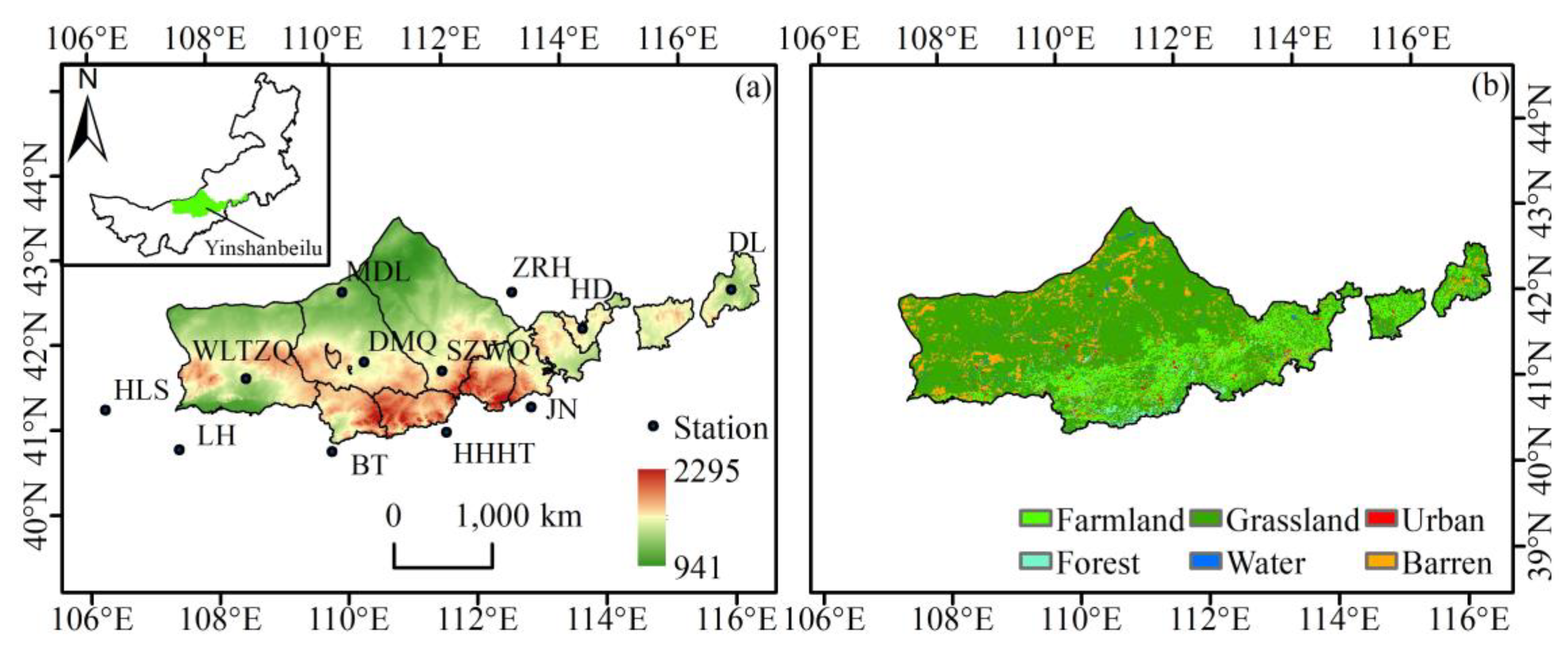

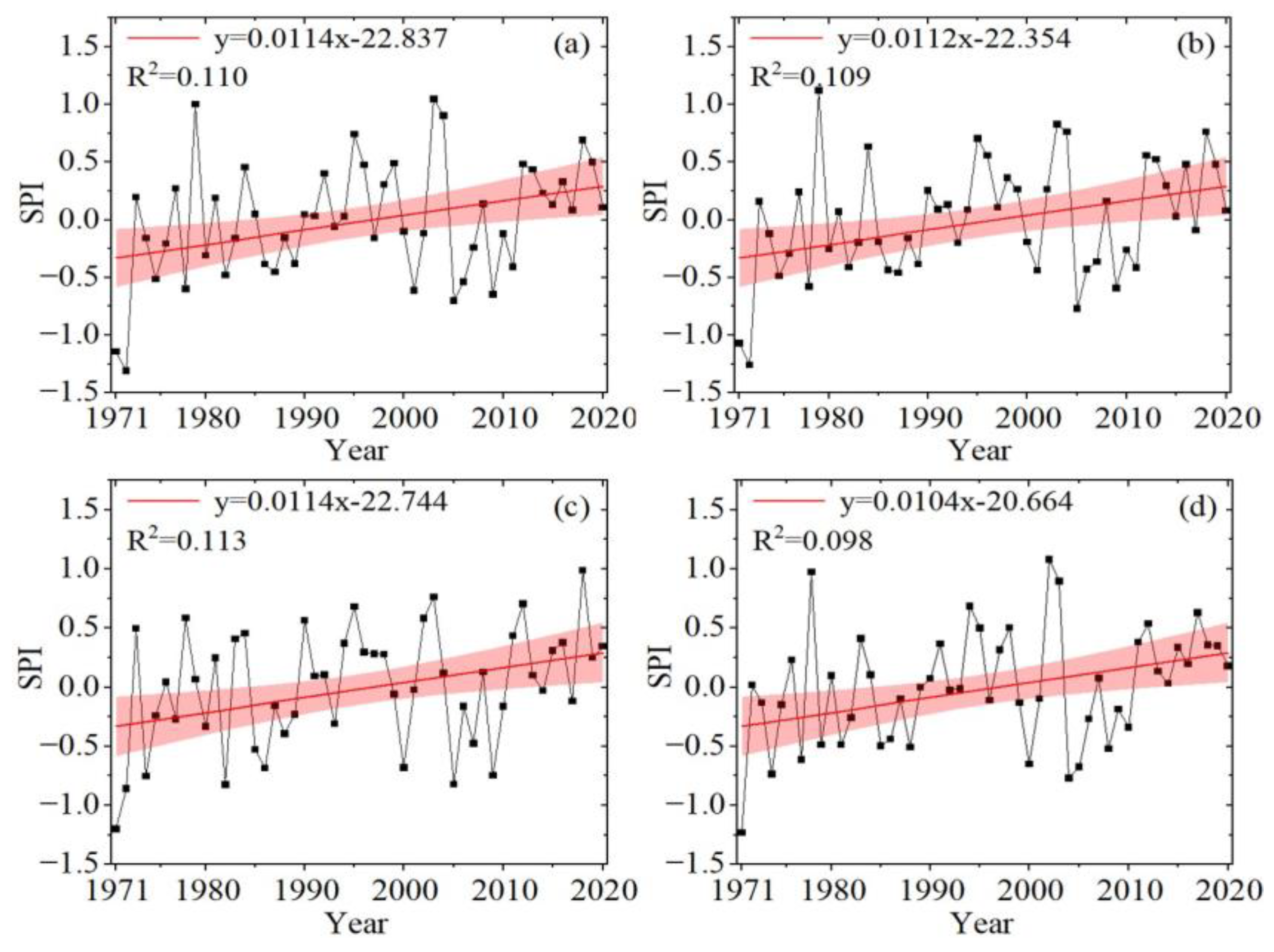
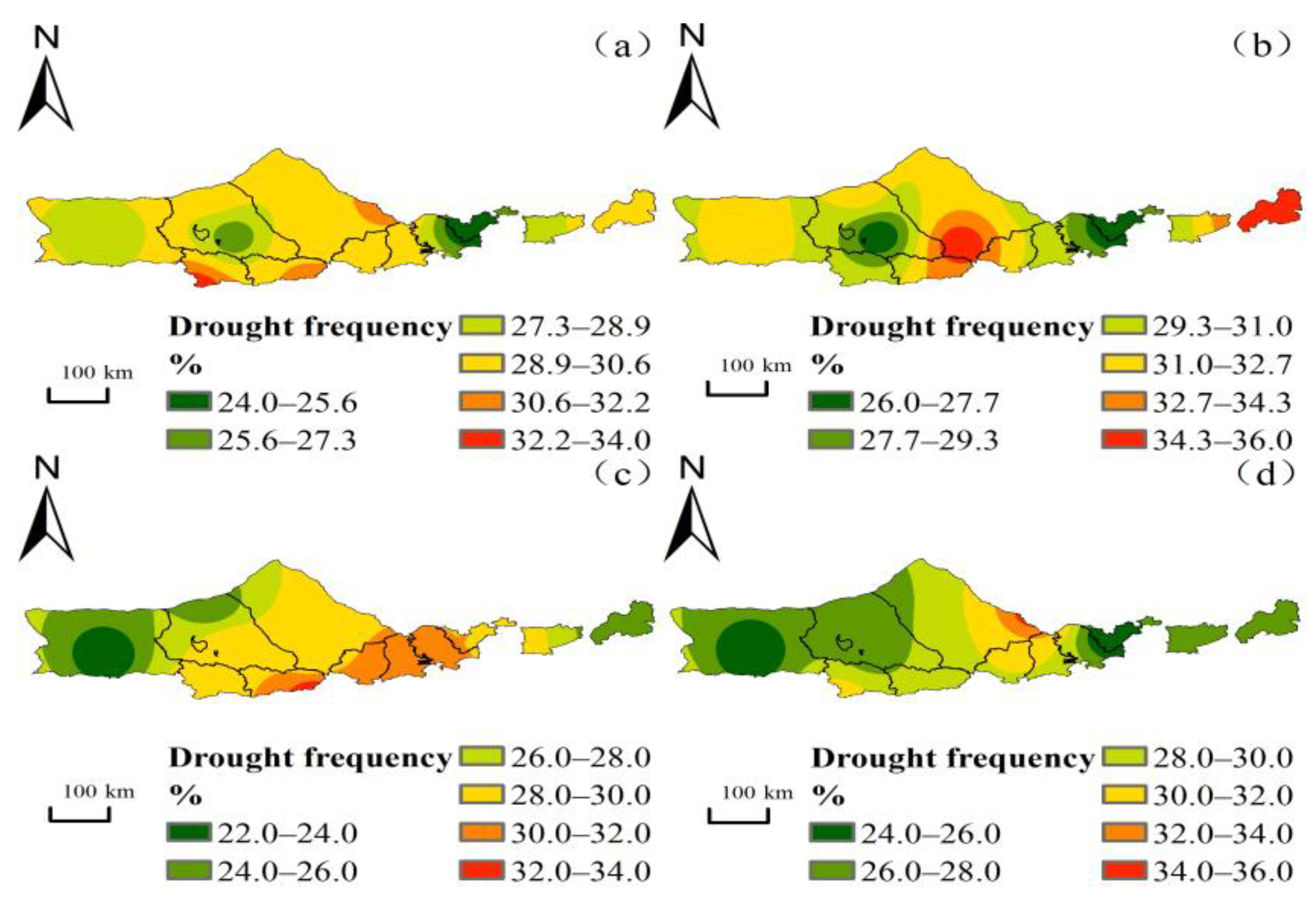

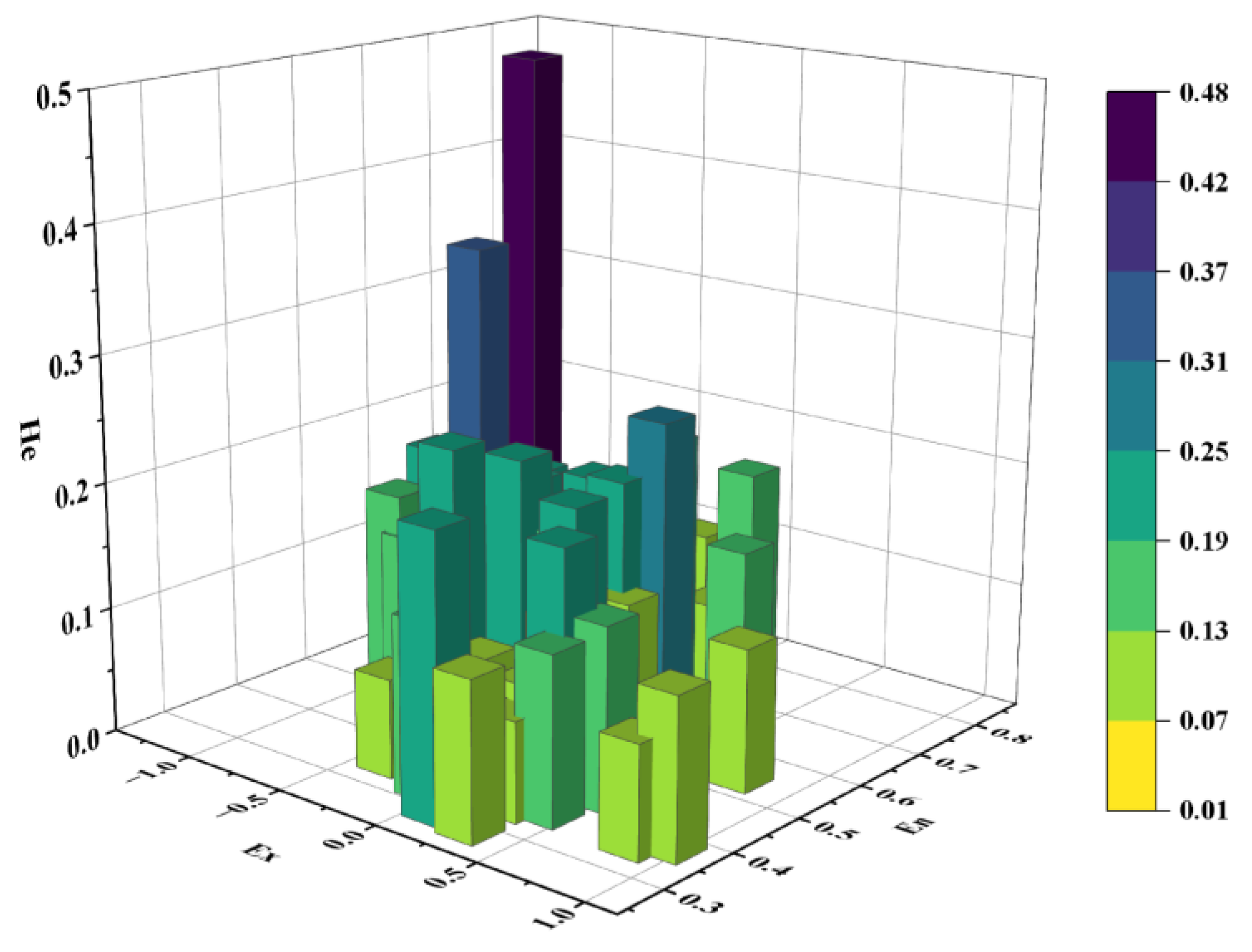


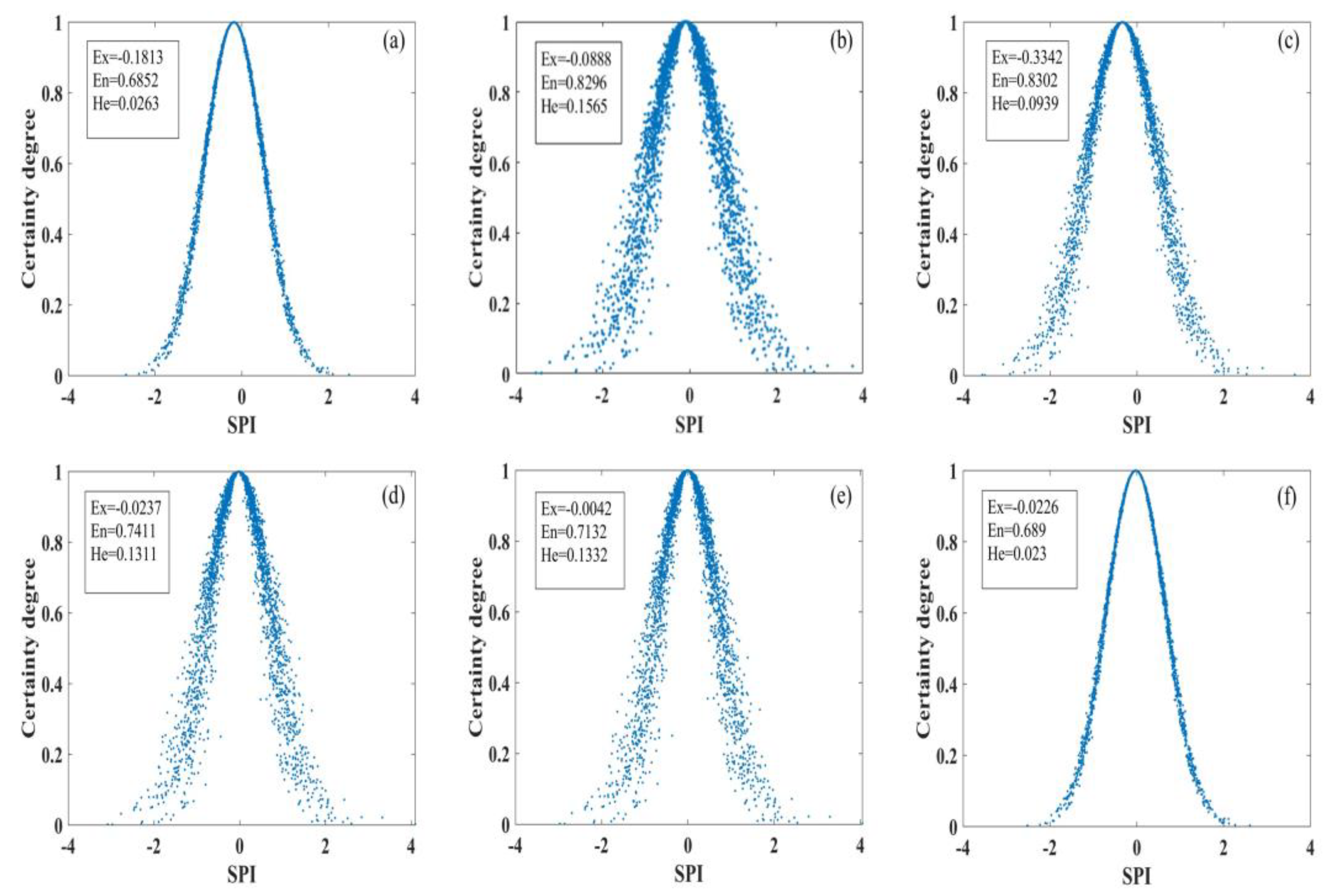
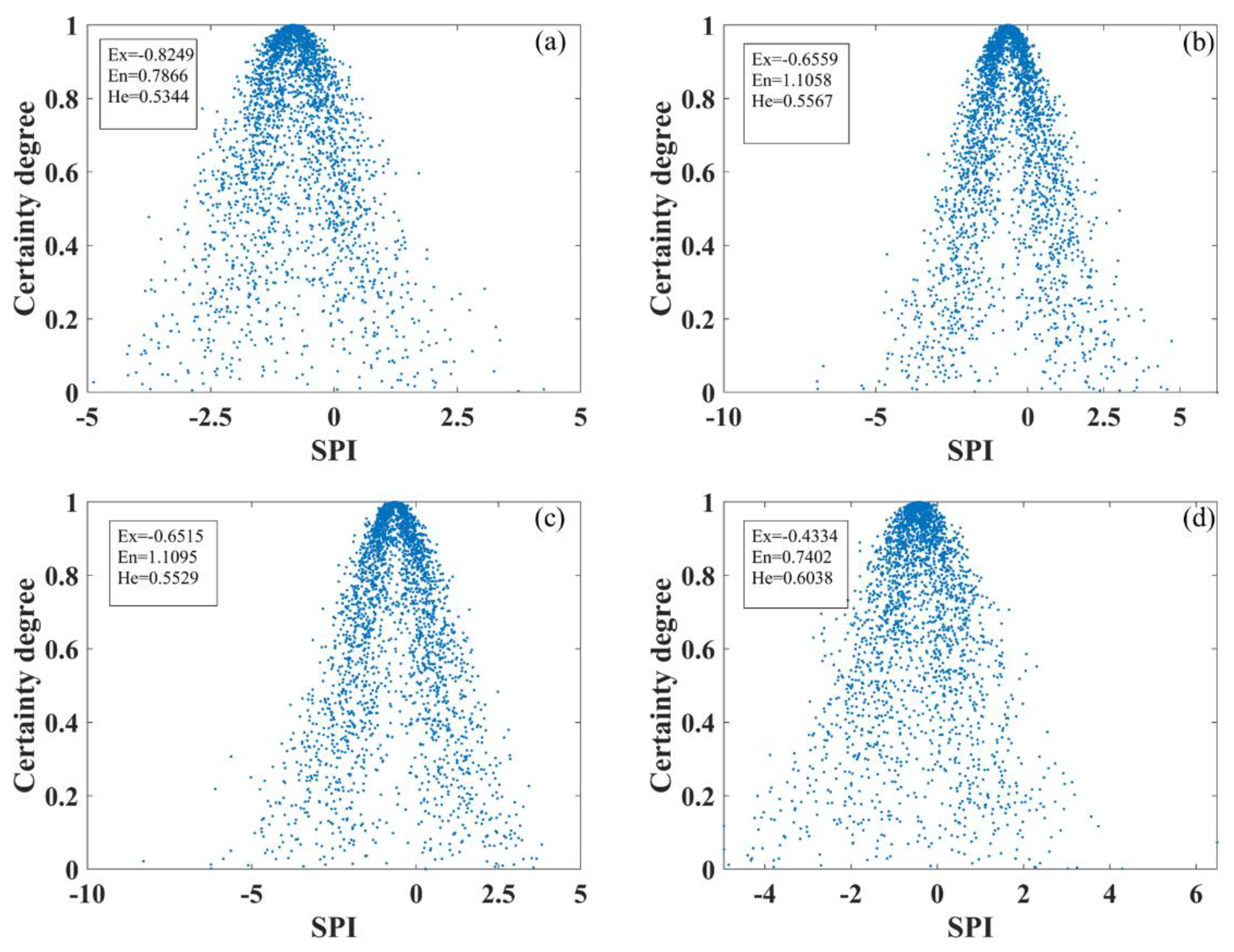

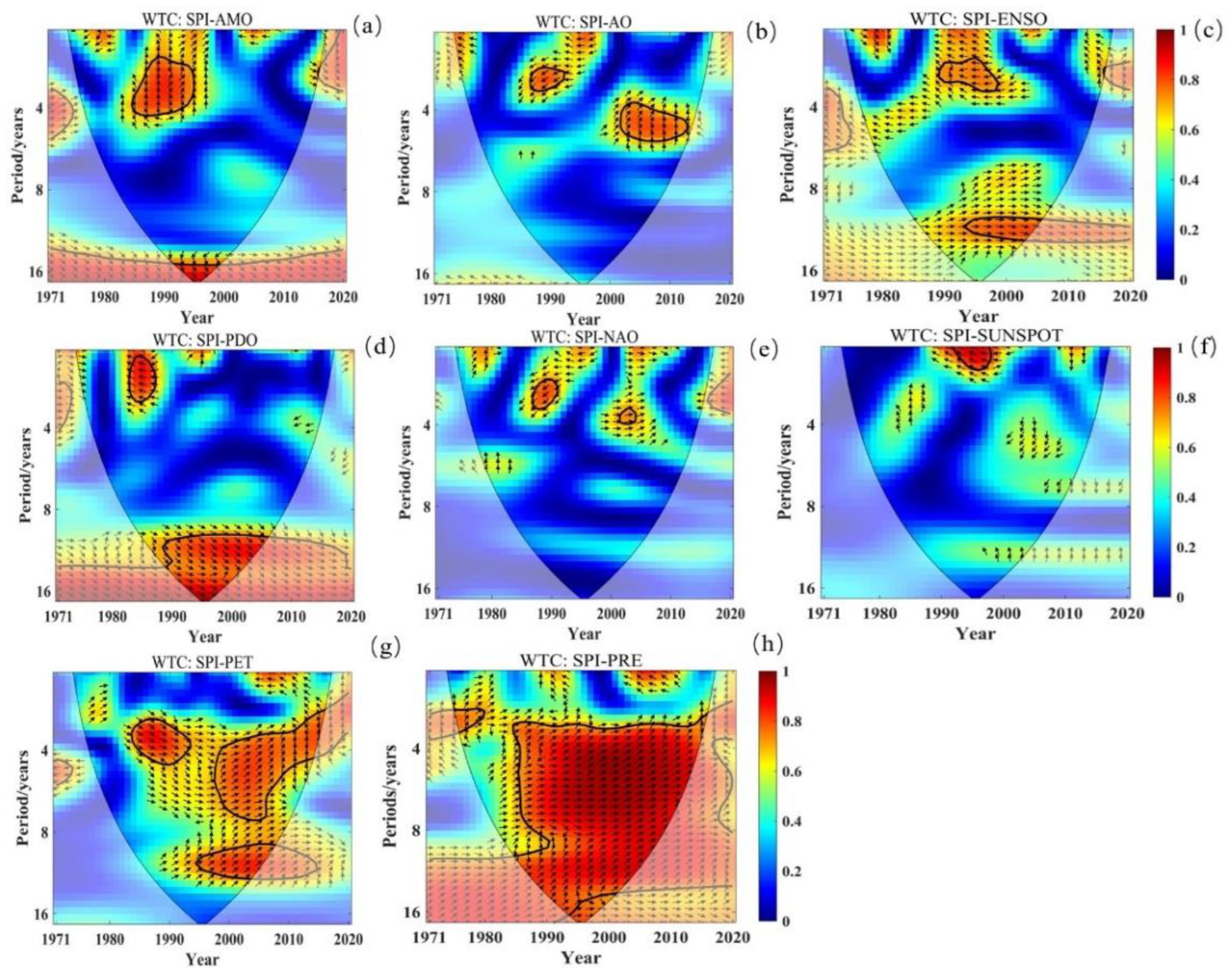
| Climatic Factor | Time Scale | Data Sources |
|---|---|---|
| ENSO | 1971–2020 | “https://www.esrl.noaa.gov/psd/data/correlation/nina34.data (accessed on 26 October 2023)” |
| PDO | 1971–2020 | “https://psl.noaa.gov/gcos_wgsp/Timeseries/PDO/(accessed on 26 October 2023)” |
| AO | 1971–2020 | “https://psl.noaa.gov/gcos_wgsp/Timeseries/AO/(accessed on 26 October 2023)” |
| NAO | 1971–2020 | “https://psl.noaa.gov/gcos_wgsp/Timeseries/NAO/(accessed on 26 October 2023)” |
| AMO | 1971–2020 | “https://psl.noaa.gov/gcos_wgsp/Timeseries/AMO/(accessed on 26 October 2023)” |
| sunspot | 1971–2020 | “https://www.side.be/sunspot-data (accessed on 26 October 2023) |
| PET | 1971–2020 | “https://cds.climate.copernicus.eu/cdsapp#!/dataset/reanalysis-era5-land-monthly-means?tab=form (accessed on 25 December 2023)” |
| PRE | 1971–2020 |
| Hierarchy | Type | SPI |
|---|---|---|
| I | No Drought | SPI > −0.5 |
| II | Slight Drought | −1.0 < SPI ≤ −0.5 |
| III | Moderate Drought | −1.5 < SPI ≤ −1.0 |
| IV | Severe Drought | −2.0 < SPI ≤ −1.5 |
| V | Extreme Drought | SPI ≤ −2.0 |
| Parameter | Season | Drought | Slight Drought | Moderate Drought | Severe Drought | Extreme Drought |
|---|---|---|---|---|---|---|
| Frequency | Spring | 29.5% | 12.8% | 10.0% | 6.7% | 0.0% |
| Summer | 31.0% | 14.7% | 9.8% | 4.2% | 2.3% | |
| Autumn | 28.3% | 16.0% | 7.8% | 2.8% | 1.7% | |
| Winter | 34.6% | 15.8% | 10.6% | 4.8% | 3.4% |
| Type | SPI-12 |
|---|---|
| ENSO | 0.003 |
| PDO | −0.018 |
| AO | 0.164 |
| NAO | 0.161 |
| AMO | −0.200 |
| sunspot | 1.000 ** |
| PET | 0.259 |
| PRE | 0.215 |
Disclaimer/Publisher’s Note: The statements, opinions and data contained in all publications are solely those of the individual author(s) and contributor(s) and not of MDPI and/or the editor(s). MDPI and/or the editor(s) disclaim responsibility for any injury to people or property resulting from any ideas, methods, instructions or products referred to in the content. |
© 2024 by the authors. Licensee MDPI, Basel, Switzerland. This article is an open access article distributed under the terms and conditions of the Creative Commons Attribution (CC BY) license (https://creativecommons.org/licenses/by/4.0/).
Share and Cite
Zhang, Z.; Fu, B.; Wang, S.; Wang, F.; Lai, H.; Zhang, W.; Feng, K.; Guo, H. Analysis of Spatiotemporal Variation Characteristics and Driving Factors of Drought in Yinshanbeilu Inner Mongolia Based on a Cloud Model. Water 2024, 16, 265. https://doi.org/10.3390/w16020265
Zhang Z, Fu B, Wang S, Wang F, Lai H, Zhang W, Feng K, Guo H. Analysis of Spatiotemporal Variation Characteristics and Driving Factors of Drought in Yinshanbeilu Inner Mongolia Based on a Cloud Model. Water. 2024; 16(2):265. https://doi.org/10.3390/w16020265
Chicago/Turabian StyleZhang, Zezhong, Bin Fu, Sinan Wang, Fei Wang, Hexin Lai, Weijie Zhang, Kai Feng, and Hengzhi Guo. 2024. "Analysis of Spatiotemporal Variation Characteristics and Driving Factors of Drought in Yinshanbeilu Inner Mongolia Based on a Cloud Model" Water 16, no. 2: 265. https://doi.org/10.3390/w16020265
APA StyleZhang, Z., Fu, B., Wang, S., Wang, F., Lai, H., Zhang, W., Feng, K., & Guo, H. (2024). Analysis of Spatiotemporal Variation Characteristics and Driving Factors of Drought in Yinshanbeilu Inner Mongolia Based on a Cloud Model. Water, 16(2), 265. https://doi.org/10.3390/w16020265






